JEEP WRANGLER 2015 JK / 3.G Owners Manual
Manufacturer: JEEP, Model Year: 2015, Model line: WRANGLER, Model: JEEP WRANGLER 2015 JK / 3.GPages: 695, PDF Size: 20.64 MB
Page 411 of 695
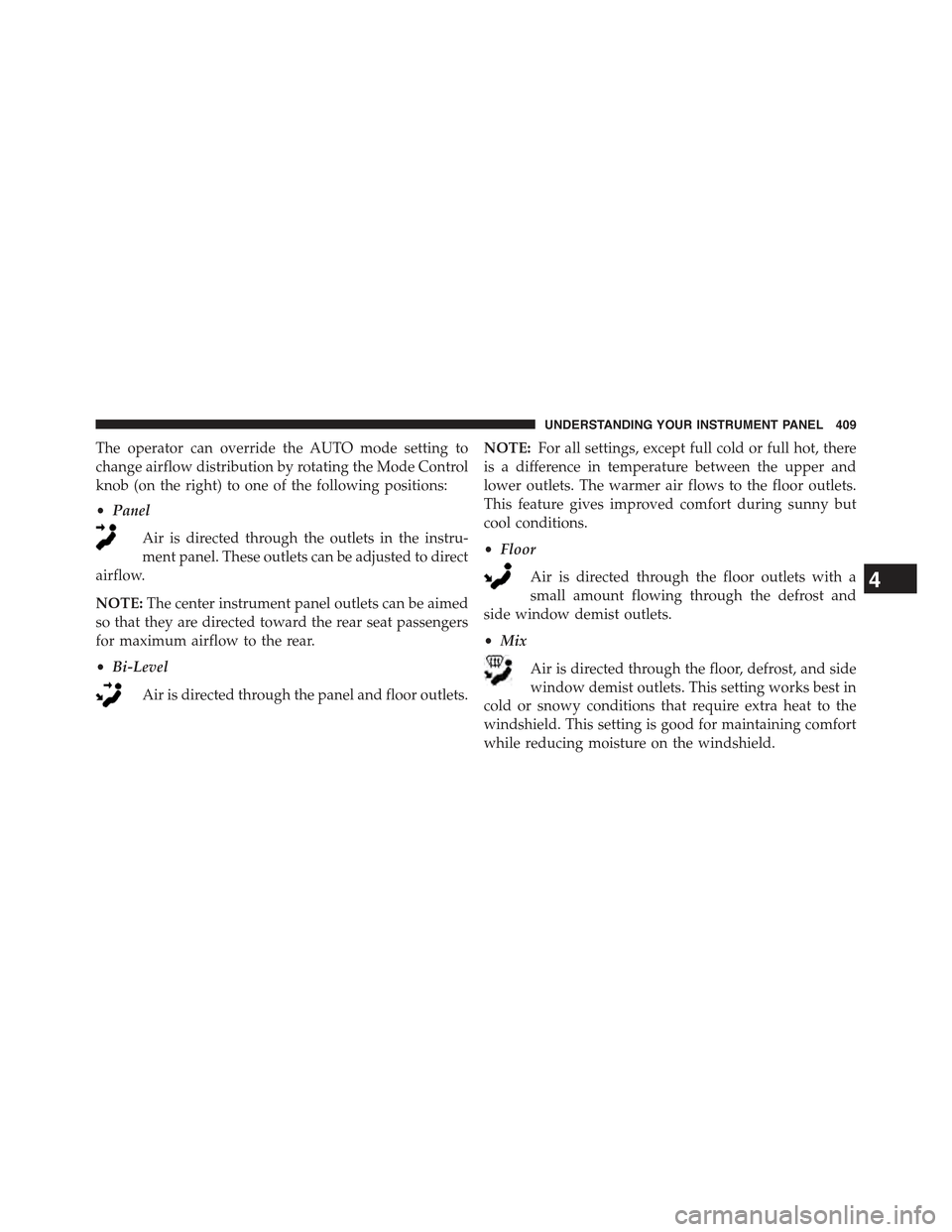
The operator can override the AUTO mode setting to
change airflow distribution by rotating the Mode Control
knob (on the right) to one of the following positions:
•Panel
Air is directed through the outlets in the instru-
ment panel. These outlets can be adjusted to direct
airflow.
NOTE:The center instrument panel outlets can be aimed
so that they are directed toward the rear seat passengers
for maximum airflow to the rear.
•Bi-Level
Air is directed through the panel and floor outlets.
NOTE:For all settings, except full cold or full hot, there
is a difference in temperature between the upper and
lower outlets. The warmer air flows to the floor outlets.
This feature gives improved comfort during sunny but
cool conditions.
•Floor
Air is directed through the floor outlets with a
small amount flowing through the defrost and
side window demist outlets.
•Mix
Air is directed through the floor, defrost, and side
window demist outlets. This setting works best in
cold or snowy conditions that require extra heat to the
windshield. This setting is good for maintaining comfort
while reducing moisture on the windshield.
4
UNDERSTANDING YOUR INSTRUMENT PANEL 409
Page 412 of 695
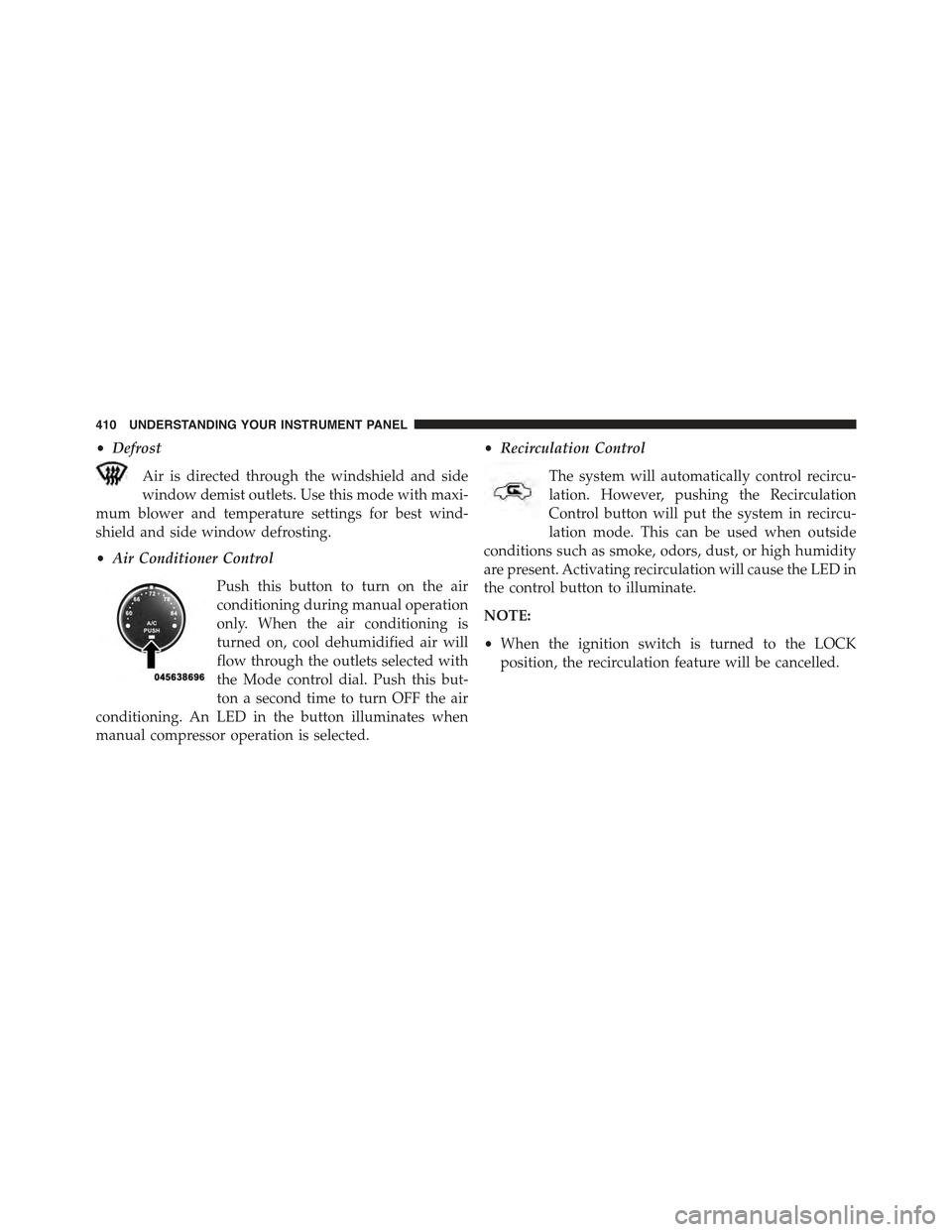
•Defrost
Air is directed through the windshield and side
window demist outlets. Use this mode with maxi-
mum blower and temperature settings for best wind-
shield and side window defrosting.
•Air Conditioner Control
Push this button to turn on the air
conditioning during manual operation
only. When the air conditioning is
turned on, cool dehumidified air will
flow through the outlets selected with
the Mode control dial. Push this but-
ton a second time to turn OFF the air
conditioning. An LED in the button illuminates when
manual compressor operation is selected.
•Recirculation Control
The system will automatically control recircu-
lation. However, pushing the Recirculation
Control button will put the system in recircu-
lation mode. This can be used when outside
conditions such as smoke, odors, dust, or high humidity
are present. Activating recirculation will cause the LED in
the control button to illuminate.
NOTE:
•When the ignition switch is turned to the LOCK
position, the recirculation feature will be cancelled.
410 UNDERSTANDING YOUR INSTRUMENT PANEL
Page 413 of 695
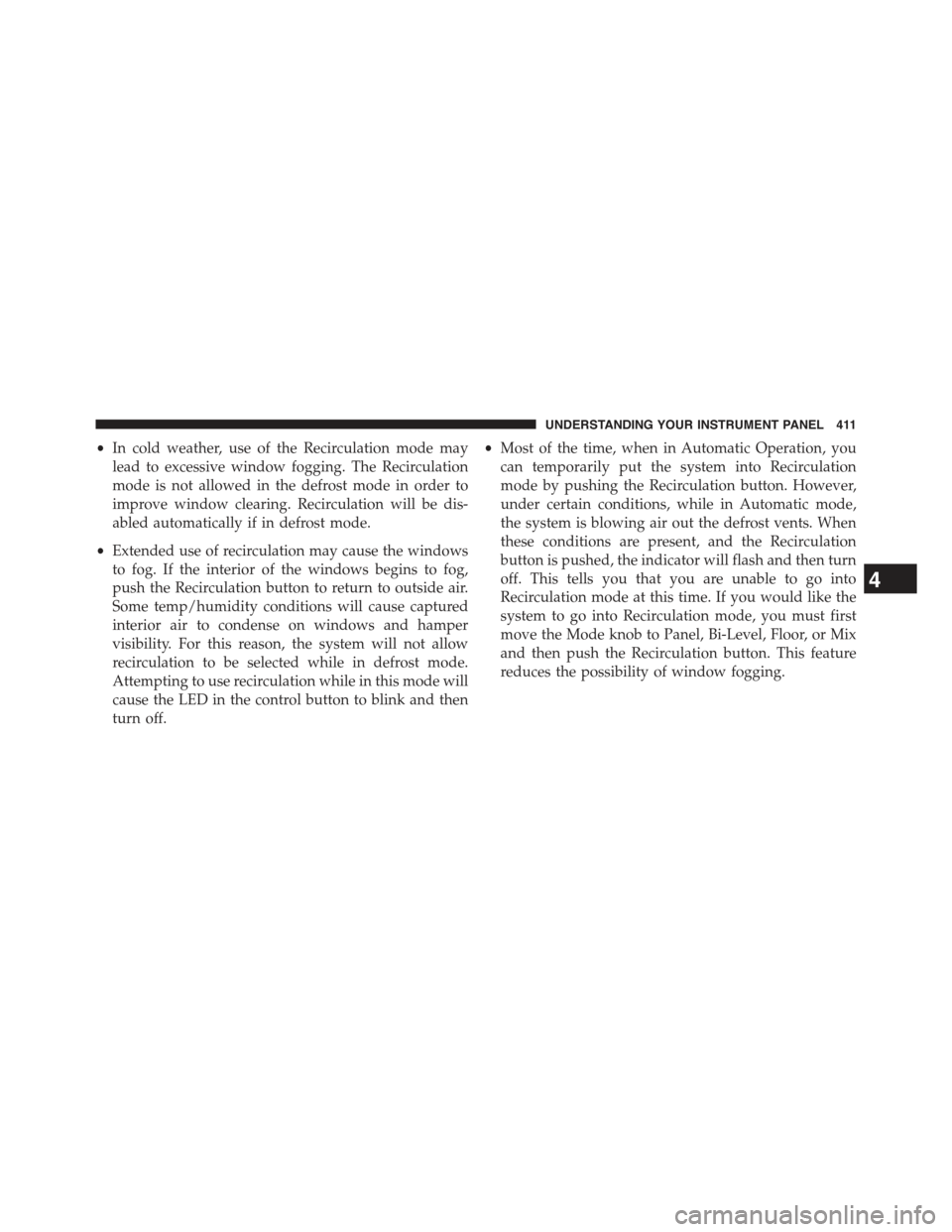
•In cold weather, use of the Recirculation mode may
lead to excessive window fogging. The Recirculation
mode is not allowed in the defrost mode in order to
improve window clearing. Recirculation will be dis-
abled automatically if in defrost mode.
•Extended use of recirculation may cause the windows
to fog. If the interior of the windows begins to fog,
push the Recirculation button to return to outside air.
Some temp/humidity conditions will cause captured
interior air to condense on windows and hamper
visibility. For this reason, the system will not allow
recirculation to be selected while in defrost mode.
Attempting to use recirculation while in this mode will
cause the LED in the control button to blink and then
turn off.
•Most of the time, when in Automatic Operation, you
can temporarily put the system into Recirculation
mode by pushing the Recirculation button. However,
under certain conditions, while in Automatic mode,
the system is blowing air out the defrost vents. When
these conditions are present, and the Recirculation
button is pushed, the indicator will flash and then turn
off. This tells you that you are unable to go into
Recirculation mode at this time. If you would like the
system to go into Recirculation mode, you must first
move the Mode knob to Panel, Bi-Level, Floor, or Mix
and then push the Recirculation button. This feature
reduces the possibility of window fogging.
4
UNDERSTANDING YOUR INSTRUMENT PANEL 411
Page 414 of 695
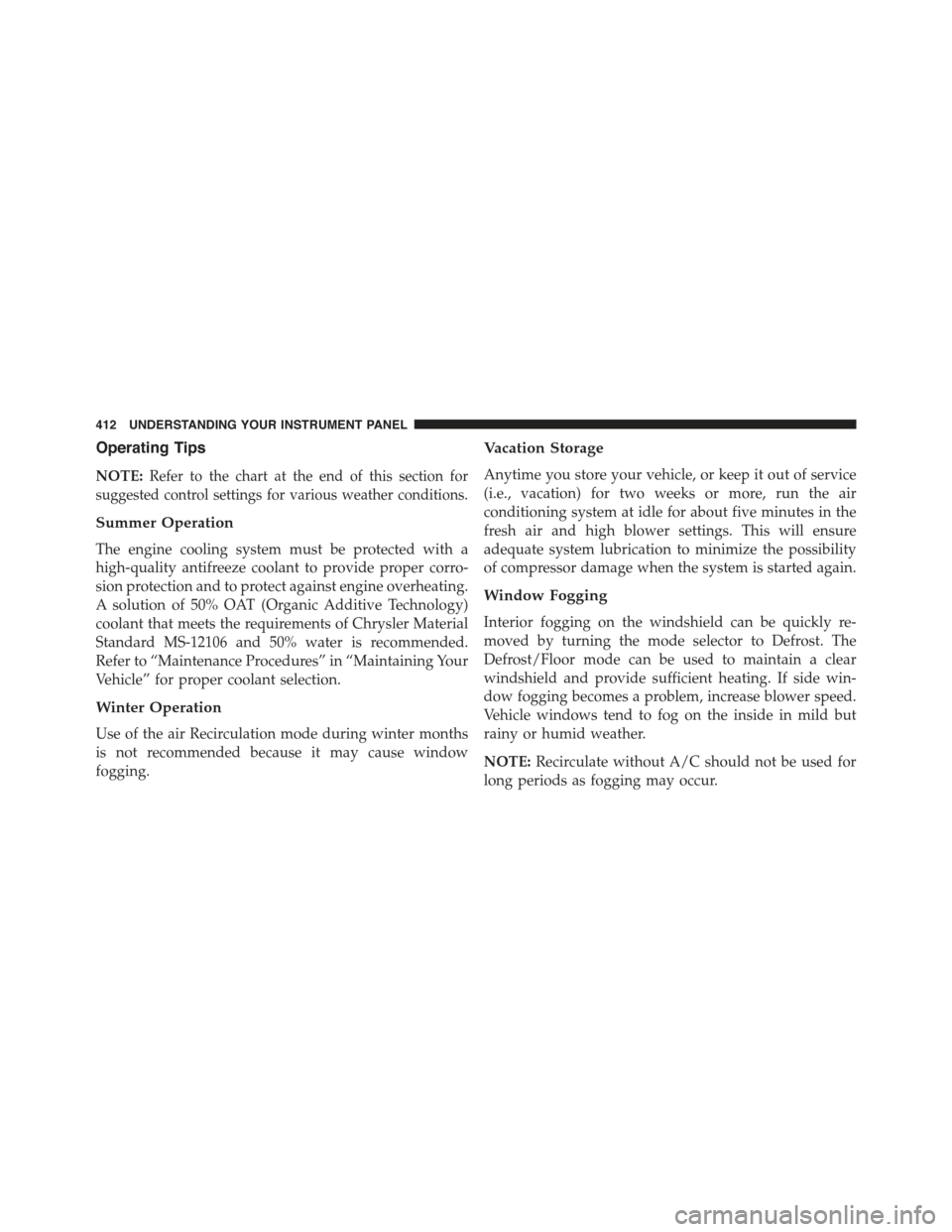
Operating Tips
NOTE:Refer to the chart at the end of this section for
suggested control settings for various weather conditions.
Summer Operation
The engine cooling system must be protected with a
high-quality antifreeze coolant to provide proper corro-
sion protection and to protect against engine overheating.
A solution of 50% OAT (Organic Additive Technology)
coolant that meets the requirements of Chrysler Material
Standard MS-12106 and 50% water is recommended.
Refer to “Maintenance Procedures” in “Maintaining Your
Vehicle” for proper coolant selection.
Winter Operation
Use of the air Recirculation mode during winter months
is not recommended because it may cause window
fogging.
Vacation Storage
Anytime you store your vehicle, or keep it out of service
(i.e., vacation) for two weeks or more, run the air
conditioning system at idle for about five minutes in the
fresh air and high blower settings. This will ensure
adequate system lubrication to minimize the possibility
of compressor damage when the system is started again.
Window Fogging
Interior fogging on the windshield can be quickly re-
moved by turning the mode selector to Defrost. The
Defrost/Floor mode can be used to maintain a clear
windshield and provide sufficient heating. If side win-
dow fogging becomes a problem, increase blower speed.
Vehicle windows tend to fog on the inside in mild but
rainy or humid weather.
NOTE:Recirculate without A/C should not be used for
long periods as fogging may occur.
412 UNDERSTANDING YOUR INSTRUMENT PANEL
Page 415 of 695
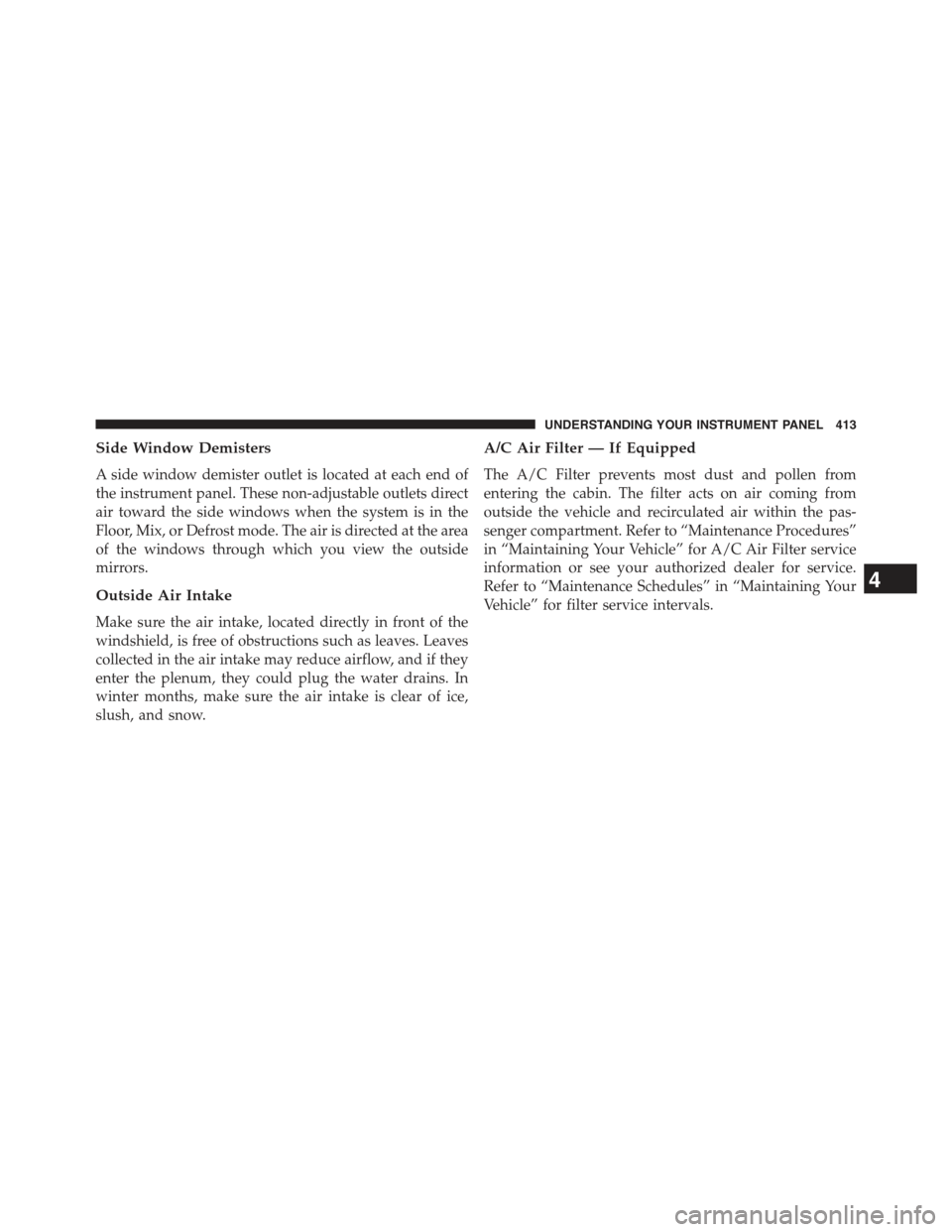
Side Window Demisters
A side window demister outlet is located at each end of
the instrument panel. These non-adjustable outlets direct
air toward the side windows when the system is in the
Floor, Mix, or Defrost mode. The air is directed at the area
of the windows through which you view the outside
mirrors.
Outside Air Intake
Make sure the air intake, located directly in front of the
windshield, is free of obstructions such as leaves. Leaves
collected in the air intake may reduce airflow, and if they
enter the plenum, they could plug the water drains. In
winter months, make sure the air intake is clear of ice,
slush, and snow.
A/C Air Filter — If Equipped
The A/C Filter prevents most dust and pollen from
entering the cabin. The filter acts on air coming from
outside the vehicle and recirculated air within the pas-
senger compartment. Refer to “Maintenance Procedures”
in “Maintaining Your Vehicle” for A/C Air Filter service
information or see your authorized dealer for service.
Refer to “Maintenance Schedules” in “Maintaining Your
Vehicle” for filter service intervals.
4
UNDERSTANDING YOUR INSTRUMENT PANEL 413
Page 416 of 695
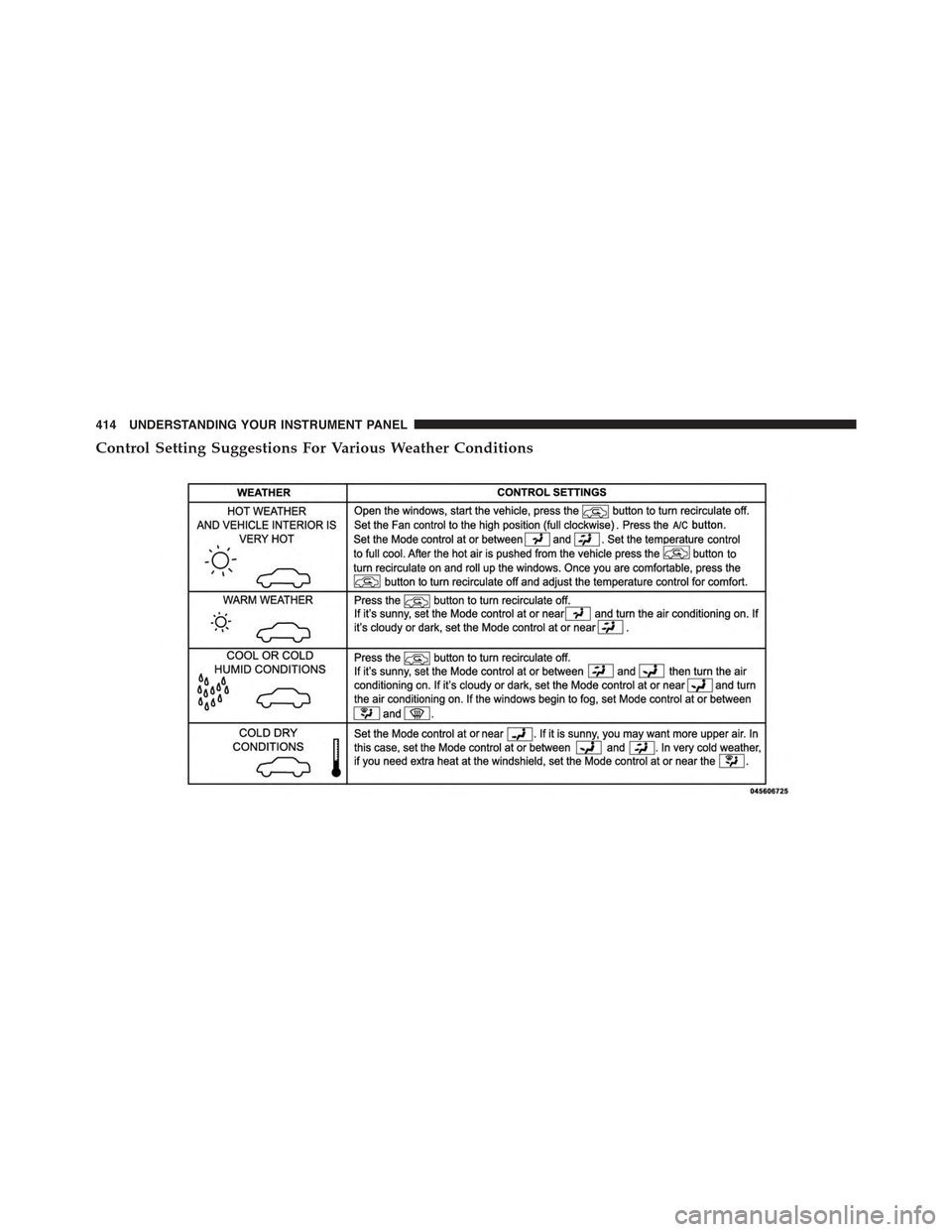
Control Setting Suggestions For Various Weather Conditions
414 UNDERSTANDING YOUR INSTRUMENT PANEL
Page 417 of 695
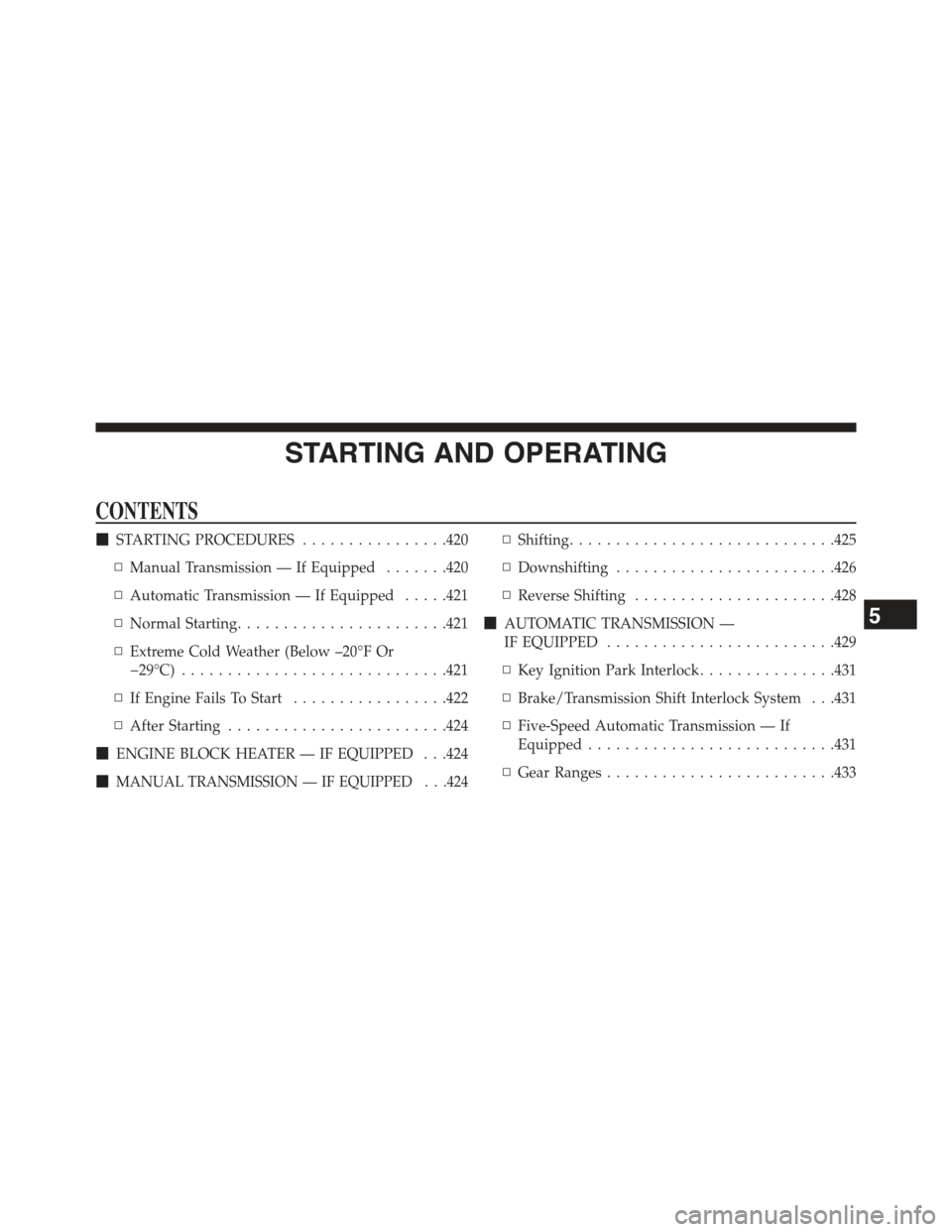
STARTING AND OPERATING
CONTENTS
!STARTING PROCEDURES................420
▫Manual Transmission — If Equipped.......420
▫Automatic Transmission — If Equipped.....421
▫Normal Starting.......................421
▫Extreme Cold Weather (Below –20°F Or
−29°C).............................421
▫If Engine Fails To Start.................422
▫After Starting........................424
!ENGINE BLOCK HEATER — IF EQUIPPED . . .424
!MANUAL TRANSMISSION — IF EQUIPPED . . .424
▫Shifting.............................425
▫Downshifting........................426
▫Reverse Shifting......................428
!AUTOMATIC TRANSMISSION —
IF EQUIPPED.........................429
▫Key Ignition Park Interlock...............431
▫Brake/Transmission Shift Interlock System . . .431
▫Five-Speed Automatic Transmission — If
Equipped...........................431
▫Gear Ranges.........................433
5
Page 418 of 695
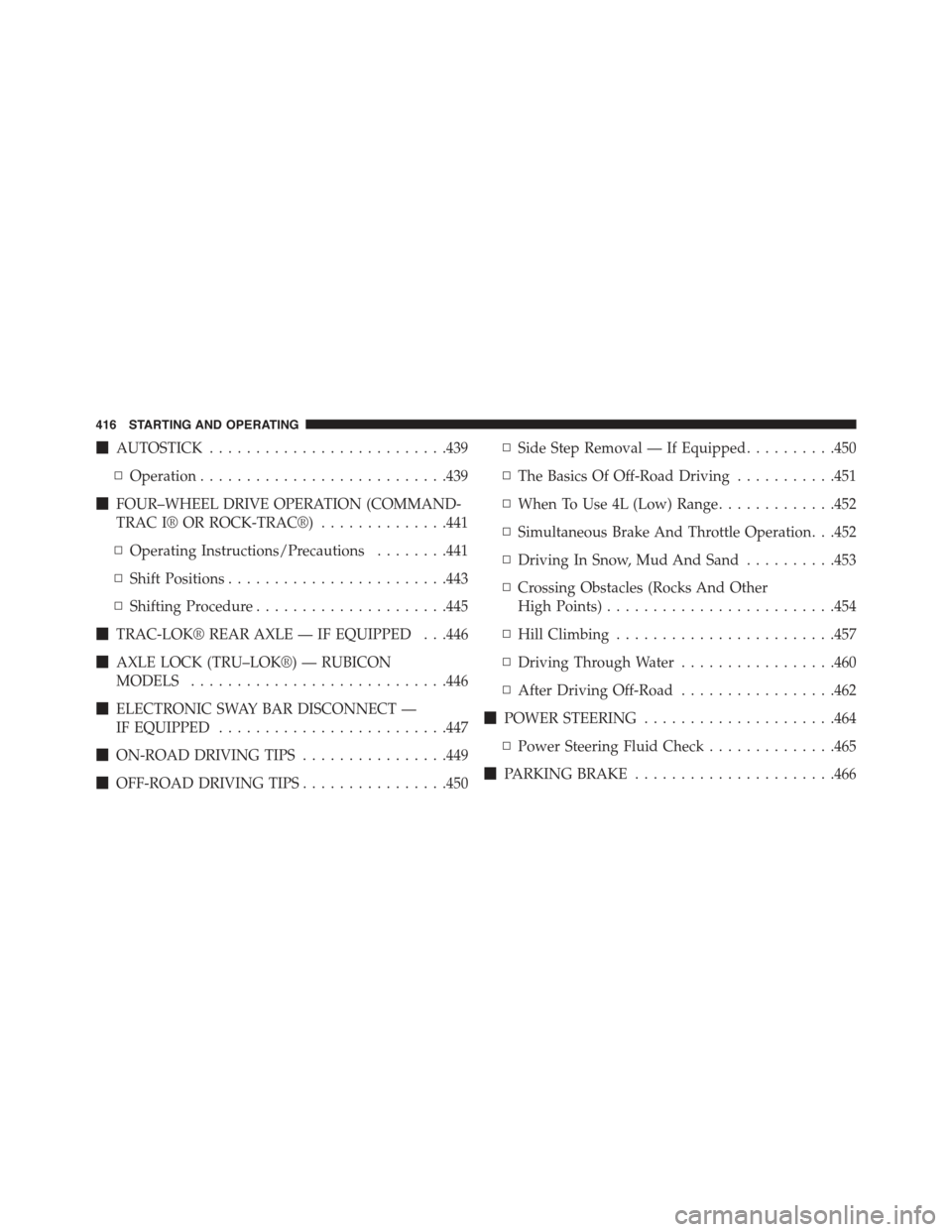
!AUTOSTICK..........................439
▫Operation...........................439
!FOUR–WHEEL DRIVE OPERATION (COMMAND-
TRAC I® OR ROCK-TRAC®)..............441
▫Operating Instructions/Precautions........441
▫Shift Positions........................443
▫Shifting Procedure.....................445
!TRAC-LOK® REAR AXLE — IF EQUIPPED . . .446
!AXLE LOCK (TRU–LOK®) — RUBICON
MODELS............................446
!ELECTRONIC SWAY BAR DISCONNECT —
IF EQUIPPED.........................447
!ON-ROAD DRIVING TIPS................449
!OFF-ROAD DRIVING TIPS................450
▫Side Step Removal — If Equipped..........450
▫The Basics Of Off-Road Driving...........451
▫When To Use 4L (Low) Range.............452
▫Simultaneous Brake And Throttle Operation. . .452
▫Driving In Snow, Mud And Sand..........453
▫Crossing Obstacles (Rocks And Other
High Points).........................454
▫Hill Climbing........................457
▫Driving Through Water.................460
▫After Driving Off-Road.................462
!POWER STEERING.....................464
▫Power Steering Fluid Check..............465
!PARKING BRAKE......................466
416 STARTING AND OPERATING
Page 419 of 695
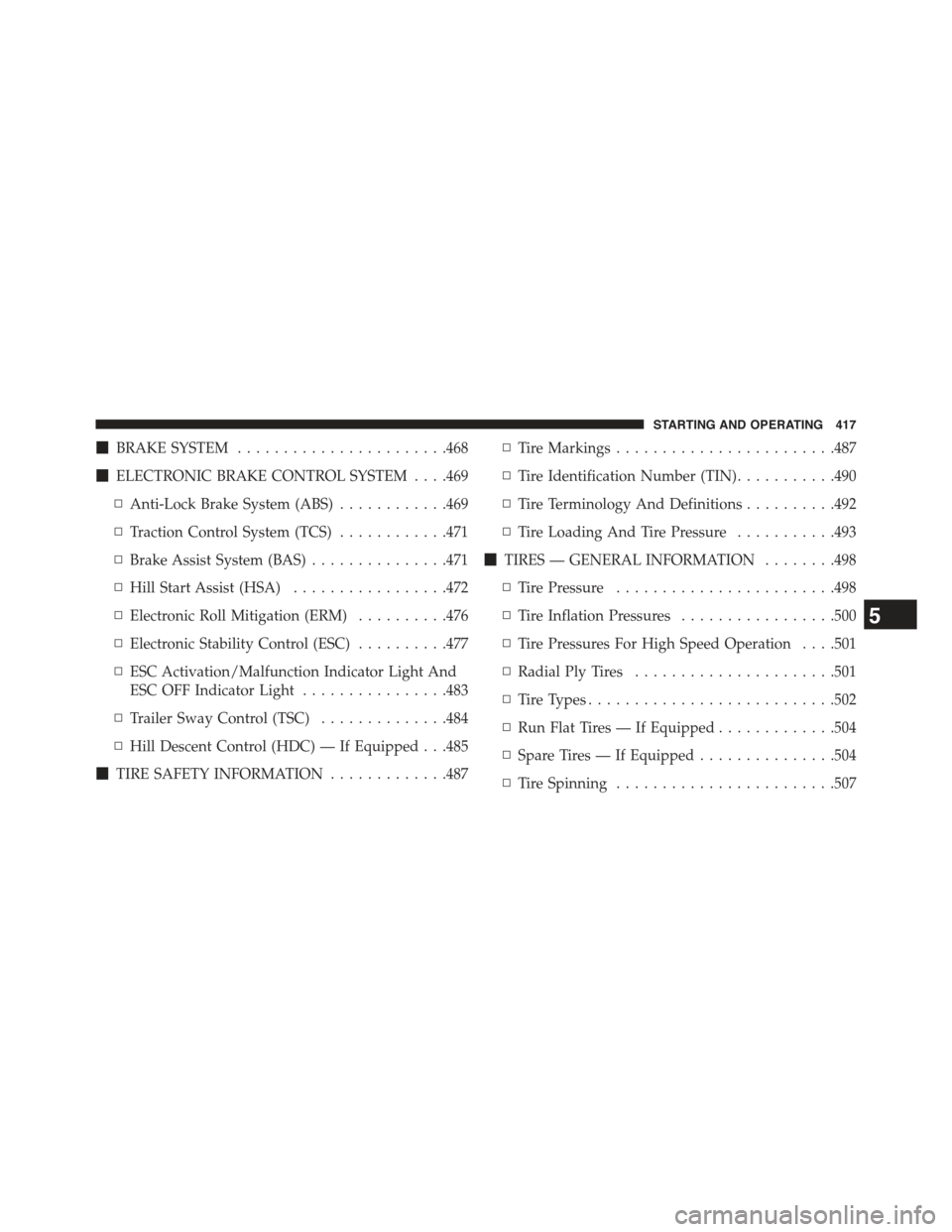
!BRAKE SYSTEM.......................468
!ELECTRONIC BRAKE CONTROL SYSTEM . . . .469
▫Anti-Lock Brake System (ABS)............469
▫Traction Control System (TCS)............471
▫Brake Assist System (BAS)...............471
▫Hill Start Assist (HSA).................472
▫Electronic Roll Mitigation (ERM)..........476
▫Electronic Stability Control (ESC)..........477
▫ESC Activation/Malfunction Indicator Light And
ESC OFF Indicator Light................483
▫Trailer Sway Control (TSC)..............484
▫Hill Descent Control (HDC) — If Equipped . . .485
!TIRE SAFETY INFORMATION.............487
▫Tire Markings........................487
▫Tire Identification Number (TIN)...........490
▫Tire Terminology And Definitions..........492
▫Tire Loading And Tire Pressure...........493
!TIRES — GENERAL INFORMATION........498
▫Tire Pressure........................498
▫Tire Inflation Pressures.................500
▫Tire Pressures For High Speed Operation . . . .501
▫Radial Ply Tires......................501
▫Tire Types...........................502
▫Run Flat Tires — If Equipped.............504
▫Spare Tires — If Equipped...............504
▫Tire Spinning........................507
5
STARTING AND OPERATING 417
Page 420 of 695
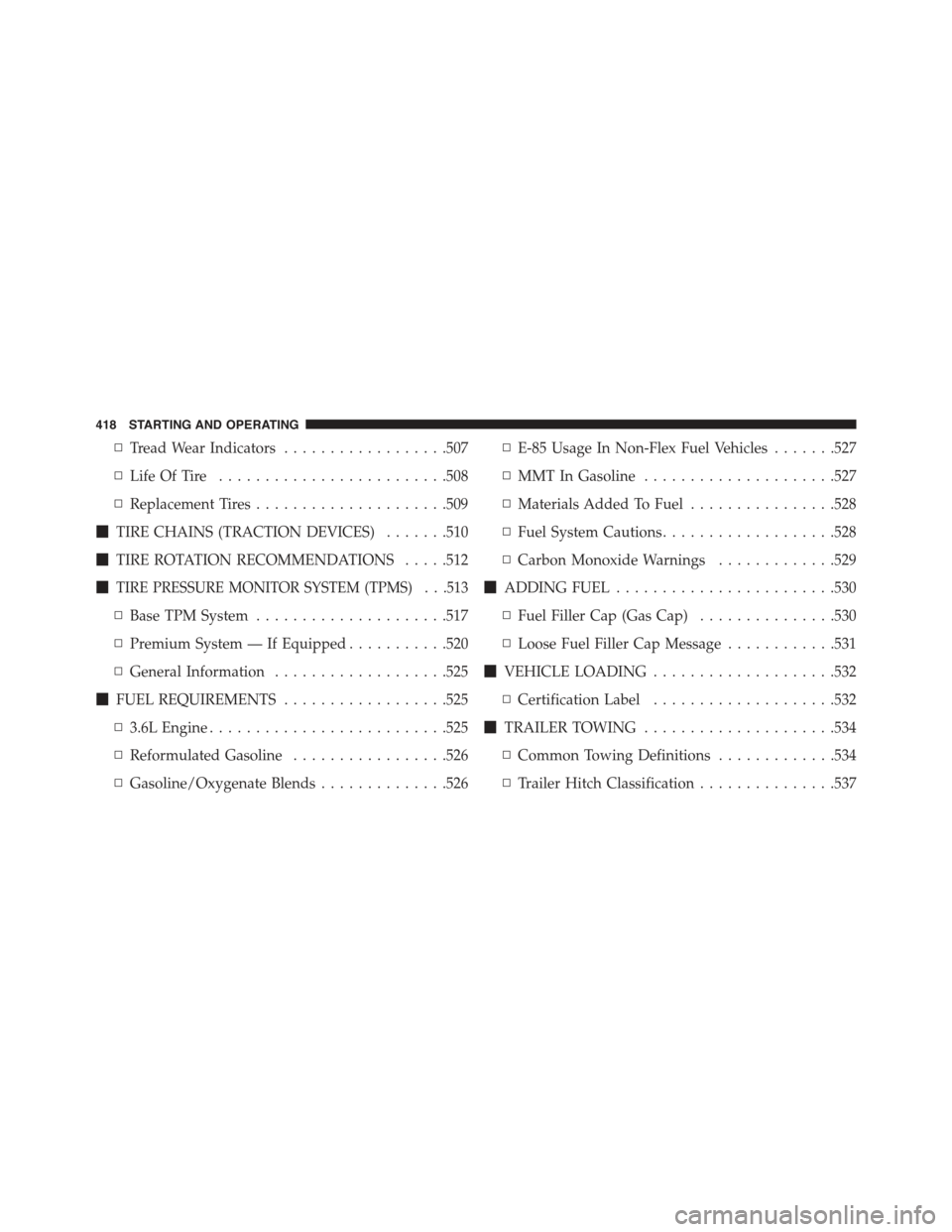
▫Tread Wear Indicators..................507
▫Life Of Tire.........................508
▫Replacement Tires.....................509
!TIRE CHAINS (TRACTION DEVICES).......510
!TIRE ROTATION RECOMMENDATIONS.....512
!TIRE PRESSURE MONITOR SYSTEM (TPMS) . . .513
▫Base TPM System.....................517
▫Premium System — If Equipped...........520
▫General Information...................525
!FUEL REQUIREMENTS..................525
▫3.6L Engine..........................525
▫Reformulated Gasoline.................526
▫Gasoline/Oxygenate Blends..............526
▫E-85 Usage In Non-Flex Fuel Vehicles.......527
▫MMT In Gasoline.....................527
▫Materials Added To Fuel................528
▫Fuel System Cautions...................528
▫Carbon Monoxide Warnings.............529
!ADDING FUEL........................530
▫Fuel Filler Cap (Gas Cap)...............530
▫Loose Fuel Filler Cap Message............531
!VEHICLE LOADING....................532
▫Certification Label....................532
!TRAILER TOWING.....................534
▫Common Towing Definitions.............534
▫Trailer Hitch Classification...............537
418 STARTING AND OPERATING